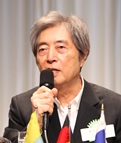Activities of ��The Great Forest Wall Project��
April 24, 2013
Mr. Morihiro Hosokawa
President, Public Interest Incorporated
Foundation ��Making the most of
Rubble : The Great Forest-Wall Project��

��At the outset of my speech today on ��The Great Forest Wall Project��, let me express my sincere gratitude to the Rotary Club of Tokyo for your generous support since our foundation was established. There are some signs of improvements in our economy. But I believe true recovery and progress of Japan can be achieved only when we have reconstructed the damages caused by the Great East Japan Earthquake of two years ago. We are committed to this project with our determination to accelerate recovery of the quake-hit areas.
��Reconstruction of affected areas has made little progress. Many earthquake survivors still live in shelters, being thrown out of their job. As time goes by, I fear our feelings towards these areas fade away. I decided to take action and established the public-interest corporation ��Making the most of Rubble: The Great Forest-Wall Project�� last July, together with a botanist, Mr. Akira Miyawaki, Professor Emeritus of Yokohama National University.
��We plan to build up a 300-kilometer-long embankment on the Pacific coast of eastern Japan, making the best use of rubbles, and plant 30-centimeter-tall seedlings of many different evergreen broadleaf trees indigenous to the area, including Japanese chinquapin and oak. Our goal is to raise an abundant tide-protection forest in a few decades that will protect our lives from huge tsunamis.
��Post-disaster rubbles are considered nuisance and other local municipalities hesitate to accept them for final treatment and disposal. By making the best use of rubbles in the vicinity, instead of transporting them across the country over a long distance, it will offer an ideal kill-two-birds-with-one-stone solution. In reality, however, we received strong resistance from the Ministry of the Environment insisting that rubbles could not be used for such purpose and they should be transported to local municipalities across the country for incineration disposal under the principle of ��cross-jurisdictional�� waste treatment. After going through extensive discussions with the related ministries and agencies, we managed to launch our Project, yet there remains much to be done.
��Utilizing debris for reclamation work is not new. For example, the Yamashita Park in Yokohama or the Sotobori (outer moat) Street in Tokyo was constructed, utilizing mass debris from the 1923 Great Kanto Earthquake. We know in other countries, debris from World War II, sometimes even tanks, are buried in the abundant forests in Berlin, Munich and Rotterdam.
��Building a mound of debris-soil mix is perfect for planting trees, as it allows air to pass through much easier than conventional mound of soil. Experiences in the worst-damaged towns in Minamisanriku and Ofunato proved that Machilus thunbergii can be one of the best tide-resistant trees, as they root deep and straight into the soil. Our Project plans to plant tens of millions of seedlings in 10 years. We did tree-planting at Otsuchi (Iwate Prefecture) last April, at Iwanuma (Miyagi Prefecture) last May and at Yamamoto (Miyagi Prefecture) last June. We are going to plant 30-centimeter-tall oak seedlings at Sendai and Iwanuma (Miyagi Prefecture) as well as Minamisoma (Fukushima Prefecture) from this May.
��We plan to collaborate with the government in implementing various reconstruction projects, including the Forestry Agency and the Ministry of Land, Infrastructure, Transport and Tourism (MLIT). For example, we assist the project implemented by the Forestry Agency to re-establish the coastal forests in eastern Japan damaged by the tsunami. We will also start working on a pilot project this June, in collaboration with MLIT, and plant seedlings on the landward-slope of roads or embankments that will serve to mitigate tsunami damages and furnish greenery.
��We must work harder and grow seedlings for these projects. It costs about 500 yen to make one seed grow into a 30-centimeter-tall seedling in eastern Japan, as the cold climate requires using plastic greenhouses. We have to organize various fundraising events to secure necessary funds. We held a unique auction in Tokyo last week, not selling goods but selling ��rights,�� including the ��right to feed carrots to the renowned racehorse, Deep Impact,�� the ��right to put on three gold medals and be lifted onto the shoulder of Saori Yoshida, the outstanding Olympic Gold Medalist in wresting,�� and the ��right to appear as an extra in Toei movie.�� We managed to raise substantial funds through this entertaining auction. I wish to continue such enjoyable auctions for fund-raising, also to remind us of the Earthquake that has caused tremendous suffering and damages.
��I believe our Project will mark our recovery from the Earthquake to people both in and outside Japan. It is a long-term initiative that can be handed down to future generations. Let me close my speech by asking for your continuous understanding and generous support to the Project that will continue for many decades to come.